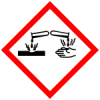The Producer must not use any pesticide listed in:
i. Annex A and B of the Stockholm Convention; or
ii. Annexes of the Montreal…
The Producer must not use any pesticide listed in:
i. Annex A and B of the Stockholm Convention; or
ii. Annexes of the Montreal…
Chemicals that are banned by the Bonsucro…

Fatal if swallowed

Causes severe skin burns and eye damage

Suspected of causing genetic defects (state route of exposure if it is conclusively proven that no other routes of exposure cause the hazard)

Suspected of damaging fertility or the unborn child (state specific effect if known)(state route of exposure if it is conclusively proven that no other routes of exposure cause the hazard)

Causes damage to organs (state all organs affected, if known) through prolonged or repeated exposure (state route of exposure if it is conclusively proven that no other routes of exposure cause the hazard)

Very toxic to aquatic life

Very toxic to aquatic life with long lasting effects
The Producer must not use any pesticide listed in:
i. Annex A and B of the Stockholm Convention; or
ii. Annexes of the Montreal…
Chemicals that are banned by the Bonsucro…

Fatal if swallowed

Causes severe skin burns and eye damage

Suspected of causing genetic defects (state route of exposure if it is conclusively proven that no other routes of exposure cause the hazard)

Suspected of damaging fertility or the unborn child (state specific effect if known)(state route of exposure if it is conclusively proven that no other routes of exposure cause the hazard)

Causes damage to organs (state all organs affected, if known) through prolonged or repeated exposure (state route of exposure if it is conclusively proven that no other routes of exposure cause the hazard)

Very toxic to aquatic life

Very toxic to aquatic life with long lasting effects